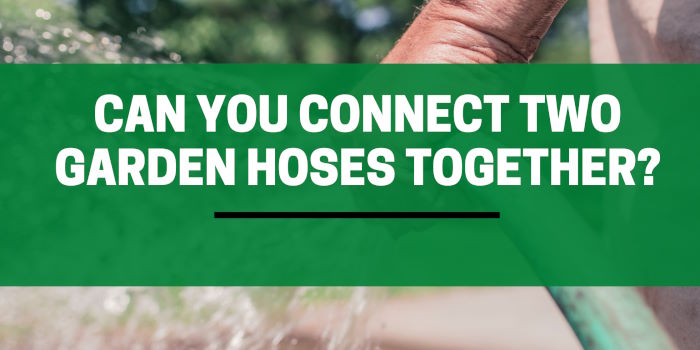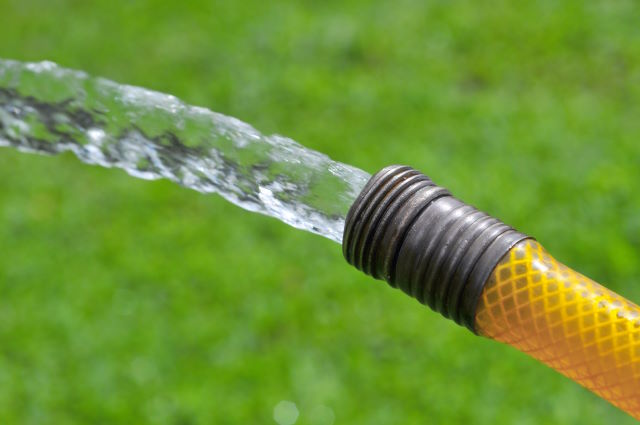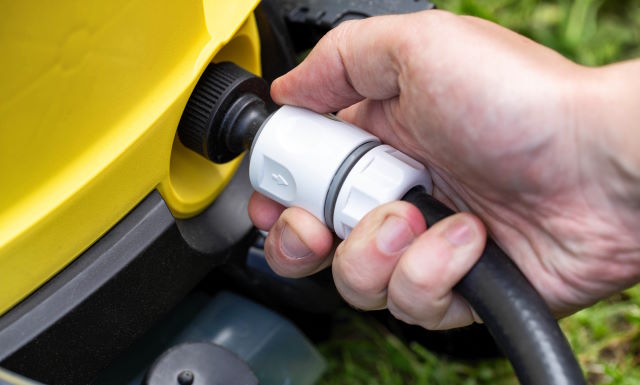
In my years tending gardens, I’ve often encountered the hose’s reach falling short.
The fix? Join multiple hoses.
It’s straightforward, and practical while ensuring every inch of your garden gets the water it needs. Let’s get right to the point of extending our hoses, making sure no plant is left thirsty.
Contents
Can I Attach Two Hoses Together?
Yes, linking two garden hoses is fairly simple if you have the correct hose fittings for your hose size.

Remember that extending your water hose will also reduce the water flow rate…
A 5/8″ 100ft hose at 40 PSI will have a flow rate reduced from 10.6 GPM to 7.3 GPM when extended to 200ft.
How To Combine Multiple Garden Hoses
Every garden hosepipe typically comes with standard fittings consisting of male and female threaded connectors. So it is quite simple to daisy chain them together.
The male connectors are threaded externally, while the female connectors have internal threading. If for any reason, a hose coupling is broken or missing, it can be replaced.
Garden Hose Thread (GHT) is the standard for most household hoses and those used a backyard. Their internal dimensions are used to determine the fitting size. Ensure that when purchasing connectors, you opt for the correct hose-fitting thread size.
Joining Two Hoses of the Same Diameter
- To ensure the two hoses are the same diameter, measure them. Common sizes include 3/4″, 5/8″, and 1/2″.
- Ensure you have a female thread connection on one and a male thread on the other.
- If one of your hoses lacks a connector, you can easily install one. Cut off the damaged or missing end (about 2 inches) using a hose cutter. Install your new connector, ensuring it’s the correct size.
- Once installed, you can combine the two hoses by screwing the male end into the female end. Turn it adequately to ensure a tight seal and solid connection for uninterrupted water flow. Use some Teflon tape to ensure a watertight and lubricated seal without leaks.
Joining Hoses of Different Diameters
Sometimes, you might want to join a larger-diameter hose to a smaller one. This is common for irrigation lines where efficient water flow and water pressure from a water source are necessary. Here are the steps to this.
- Measure the diameter of both water hoses.
- Buy an adapter with sizes that correspond to your hoses. For example, if you’re joining a 3/4-inch and 1-inch hoses, you’ll need a 3/4-inch to a 1-inch adapter.
- Attach the adapter to the larger hose, then connect the smaller one to the adapter. Ensure a secure and watertight seal to maintain an adequate flow.
Quick-Connect Adapters Or Push-In Connectors
Quick-connect fittings can be a great time-saver for those who frequently combine and disconnect hoses.

Attach the female quick-connector to one hose and the male to the other. Once installed, joining hoses becomes a simple push-and-lock mechanism.
Adapters are also available for an outdoor spigot so a pipe can be attached and detached quickly.
Hose Connection Comparison
| Hose Type | How To Connect | Simplicity (1-3) |
| Same diameter | Screw the male and female connections together | 2 |
| Different diameter | Use an adapter to screw the connections together | 3 |
| Hoses with quick-connect adapters | Attach the adapters, then push the adapters together | 1 |
Installing New Connectors To Your Garden Hoses
- Begin by removing any old fittings. Use a utility knife to make a clean cut, approximately 2 inches away from the existing fitting.
- Push the connector’s barbed rod deep into the hose. Ensure the end aligns seamlessly with the outer rim of the hosepipe.
- Tighten a crimp ring around your hose’s end. This action effectively joins your hose with its new coupling.
Now, with your first hose ready and equipped, the opposite coupling should easily twist onto it, thanks to the male and female connector dynamics.
Connector Types: Know Your Options
Understanding common hose connectors enhances the process of creating a double-length hose:
- Compression Fittings: Renowned for their robust seal, they’re considered the most durable option.
- Clamp Ring Fittings: Compact and straightforward, they can fit various hose sizes.
- Barbed Fittings: No tools are needed, but they might not last as long as other options.
Additional Tips and Considerations
- Water flow: If a hose is extended, you can expect a reduced flow rate or gallons per minute (GPM). This may be visible when you fully open the valve at your hose bib.
- Material Matters: Always consider the material of your connectors. Don’t link aluminum connectors to brass ones to avoid galvanic corrosion, which can cause the two hoses to become stuck together and compromise the connection’s integrity over time.
- Pressure Concerns: If you plan to use the connected hoses with a pressure washer, ensure the parts can withstand the washer’s flow rate and pressure.
- Prolonging the Hose Pipe’s Life: Regularly inspect your line and connectors for signs of wear and tear. Addressing minor issues promptly can save you from bigger problems down the line.
Final Thoughts
Combining two hoses is a practical solution for various tasks, from filling a distant water feature to managing more extensive irrigation projects. With the knowledge of connector types and sizes, and by ensuring a watertight seal, you can easily increase your hose length and your water supply range.
Remember, it’s essential to check for hose leaks and ensure that the connectors are made of materials that don’t promote galvanic corrosion, like aluminum with brass.
For those embarking on their first hose-extension endeavor, remember this: with the correct tools, equipment, and knowledge, you can harness the flow of water precisely where you need it.
